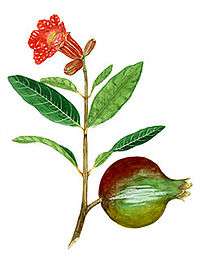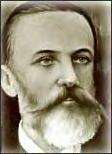Agustín Stahl
| Dr. Agustín Stahl Stamm | |
|---|---|
|
A Puerto Rican scientist | |
| Born |
Agustín Stahl Stamm January 21, 1842 Aguadilla, Puerto Rico |
| Died |
July 12, 1917 Bayamón, Puerto Rico |
| Nationality | Puerto Rican |
| Occupation | Medical doctor, scientist |
| Notes | |
|
Dr. Stahl has a genus, Stahlia, and five valid species, Argythamnia stahlii, Senna pendula var. stahlii , Eugenia stahlii, Lyonia stahlii, and Ternstroemia stahlii, named in his honor. | |
Dr. Agustín Stahl (January 21, 1842 – July 12, 1917) was a Puerto Rican medical doctor and scientist with diverse interests in the fields of ethnology, botany, and zoology. He advocated Puerto Rico's independence from Spain.
Early years
Stahl was born in Aguadilla, Puerto Rico and given the name Antón Adolf August, by his parents Johann Heinrich Christian Stahl and María Helene Stamm. Born into a Protestant family, he was baptized into the Catholic faith in Aguadilla at about three years of age,[1] town where he also received his primary and secondary education.
He studied at the universities of Würzburg and Prague (at the Charles University), graduating from the latter with the title of Doctor of Medicine in 1864. After graduation, Stahl returned to Puerto Rico where he established his medical practice in the city of Bayamón.
Ethnologist, botanist and zoologist

Outside work, Stahl's love of nature lead him to conduct investigations and experiments in the fields of ethnology, botany and zoology. He also had a love of history and historical investigation.
Stahl wrote "Estudios sobre la flora de Puerto Rico" (A study of the Puerto Rican Flora), published in 6 fascicles from 1883-88. Copies of Stahl's plant collection with approximately 1,330 plants can be found in various botanical gardens around the world. His collections were the basis for numerous studies by specialists, some of them resulting in new taxa to science.[2]
Stahl has a genus, Stahlia, and five valid species, Argythamnia stahlii, Senna pendula var. stahlii , Eugenia stahlii, Lyonia stahlii, and Ternstroemia stahlii, named in his honor.[3] The genus Stahlia is represented by a single species, S. monosperma (Tul.) Urb., known to occur only in Puerto Rico and the eastern Dominican Republic. Known in Puerto Rico as Cóbana Negra, this species is currently listed as threatened in the USFW Federal Register, April 5, 1990.
Written works
Stahl's written works include:
- Notes on Puerto Rico's Flora
- Report on the Disease of the Sugar Cane
- Puerto Rican Flora
- The Puerto Rican Indians (Tainos)
- The Founding of Aguadilla
- The Founding of Bayamón
Later years
The custom of adorning Christmas trees in Puerto Rico began in the city of Bayamón in 1866 when Stahl adorned a tree in his back yard. The people of Bayamón baptized his tree "El árbol de Navidad del Doctor Stahl" (Dr. Stahl's Christmas tree).[5]
Stahl was a firm believer that Puerto Rico should obtain independence from Spain, and was a member of the "Partido Autonomista Puertorriqueño", or Puerto Rican Autonomist Party. This group sought to create a separate political and legal identity for Puerto Rico while emulating Spain in all political matters. However, due to Stahl's political views, he was expelled from his position in the Civil Institute of Natural Sciences in Spain and was deported from Spain in 1898.[6]
Stahl died in the city of Bayamón and his remains are buried in Bayamón's Municipal Cemetery. The city of Bayamón turned his former house into a museum to be enjoyed by all those who wish to learn more about him and his work. The Puerto Rican sculptor Tomás Batista created a bust to honor Stahl which can be found at the University of Cayey.[6]
Further reading
- A. Stahl, Flora De Puerto Rico: Acuarelas De Agustin Stahl Publicadas Por El Fideicomiso De Conservacion De Puerto Rico En Ocasion De Su Vigesimoquinto Aniversario. ISBN 0-9633429-0-8
- Chardon, C. E. 1924. Haciendo Patria. Homenaje al Dr. Agustín Stahl. Revista de agricultura de Puerto Rico. 12(11): 65-84.
- Coll y Toste, C. 1926. Destierro del Dr. Stahl. Expulsión del Dr. Agustín Stahl de la isla. Boletín Histórico de Puerto Rico. Tomo 13: 59-60.
- Gutierrez de Arroyo, I. 1978. El Dr. Agustín Stahl, Hombre de ciencia: Perspectiva Humanística [with bibliography]. Universidad de Puerto Rico, Río Piedras.
See also
- List of Puerto Ricans
- Puerto Rican scientists and inventors
- German immigration to Puerto Rico
- Dr. Agustín Stahl Stamm House
References
- ↑ Temas y temitas, by Haydée Reichard de Cancio, pgs. 43-44.
- ↑ Botanical Legacy of Dr. Agustín Stahl, Retrieved October 17, 2008
- ↑ "Flora of Puerto Rico and the Virgin Islands". Archived from the original on 2006-09-01. Retrieved 2006-09-17.
- ↑ IPNI. A. Stahl.
- ↑ El Primer Arbol de Navidad de Puerto Rico
- 1 2 Chardon, C. E. 1924. Haciendo Patria. Homenaje al Dr. Agustín Stahl. Revista de agricultura de Puerto Rico. 12(11): 65-84.
External links
- "Agustin Stahl, The Virtual Museum of Natural History of Puerto Rico", Website
- P. Acevedo-Rodrguez, "The Botanical Legacy of Agustín Stahl", National Museum of Natural History, Smithsonian Institution (English); also Spanish.
